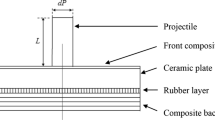Abstract
An analytic method is proposed to estimate ballistic limits of ceramic-FRP composite armors. In this method the ballistic limit is evaluated using energy balance approach, that is, the kinetic energy of a projectile just before striking against the armor is assumed to be equal to the sum of energies absorbed during the penetration. The absorbed energies are divided into three parts as follows: the ones absorbed during the penetration into the ceramic facing and the FRP backing, respectively, and the elastic deformation energy of FRP backing. Through comparisons with Wilkins' experimental results this method is shown to be effective to estimate the ballistic limit of composite armors which consist of 4.064mm to 8.635mm thick AD85 ceramic plate and 4.445mm to 9.525mm thick glass FRP plate.
Similar content being viewed by others
Abbreviations
- D :
-
Diameter of projectile
- D p :
-
Stiffness of plate
- E :
-
Young's modulus
- E o :
-
Kinetic energy just before strike
- E 1 :
-
Energy absorbed during penetration of ceramic facing
- E 2 :
-
Energy absorbed during elastic deformation of FRP backing
- E 3 :
-
Energy absorbed during penetration of FRP backing
- ε f :
-
Fracture strain
- M :
-
Mass of projectile
- ρ:
-
Distance from apex of ceramic fracture conoid
- p :
-
Pressure transmitted from ceramic to FRP backing
- r :
-
Radius
- r p :
-
Radius of elastically deformed area in FRP backing
- ϕ:
-
A half apex angle of ceramic fracture conoid
- T c :
-
Thickness of ceramic facing
- T f :
-
Thickness of FRP backing
- V bt :
-
Ballistic limit velocity
- w :
-
Displacement in z-direction
- σ t :
-
Tensile strength
- σ c :
-
Compressive yield stress
- σ s :
-
Effective strength of ceramic
References
Bless, S.J., Rozenberg, Z. and Yoon, B., 1987, “Hypervelocity Penetration of Ceramics,” Int. J. Impact Engng. Vol. 5, pp. 165–171.
Bodine, E.G., Dunleavy, J.G. and Rolsten, R.F., 1969, “The Optimization of Composite Ceramic-Armor Materials,” Symposium on Ceramic-Armor Technology, Columbus, Ohio.
Cardner, P.B., 1975, “Advances in Ceramic Composite Armor Technology,” Symposium on Vulnerability and Survivability, San Diego, California.
Cline, C.F. and Wilkins, M.L., 1969, “The Importance of Material Properties in Ceramic Armor,” Symposium on Ceramic-Armor Technology, Columbus, Ohio.
Du Pont De Nemours & Co. Inc, 1980, “Preparation of Composite Armor Reinforced with Fabrics of KEVLAR Aramid.”
Du Pont De Nemours & Co. Inc, 1980, “A Guide to Designing and Preparing Ballistic Protection of KEVLAR Aramid.”
Evans, A.G., Gulden, M.E., Eggum, G.E. and Rosemblatt, M., 1976, “Impact Damage in Brittle Materials in the Plastic Response Regime.” Rockwell International Science Center Report SC 5023-9TR.
Florence, A.L., 1969, “Interaction of Projectiles and Composite Armor-Part II,” AMMRC CR69-15, Stanford Research Institute.
Forrestal, M.J., Rosenberg, Z., Luk, V.K. and Bless, S.J., 1987, “Perforation of Aluminum Plates with Conical-Nosed Rods,” J. Appl. Mech. Vol. 54, pp. 230–232.
Gulbierz, I. and Bohan, C., 1980, “Evaluation of Methods to Increase the Balistic Efficiency of Alumina Face Plates for Alumina/glass-Reinforced Plastic Composite Armor Systems,” Picatinny Arsenal Technical Report 3908.
Kim, C.H. and Palmour, H., 1970, “Microstructural Alternations in Alumina Ceramics Associated with Ballistic Impact Events,” Technical Report 70-8, North Carolina State University.
Landingham, R.L. and Casey, A.W., 1972, Final Report of the Light Armor Materials Program, UCRL-51269, Livermore, Califonia.
Martin, D.M., 1969, “Pernetration Mechanics,” Symposium on Ceramic-Armor Technology, Columbus, Ohio.
Raible, R.C., 1980, “Fibrous Armor,” in Ballistic Materials and Penetration Mechanics, edited by Roy C. Laible, Elsevier, pp.73–112.
Rozenberg, Z. and Yeshurun, Y., 1987, “A New Definition of Ballistic Efficiency of Brittle Materials Based on Use of Thick Backing Plates,” Conference Impact 87, Bremen, FRG.
Rozenberg, Z. and Yeshurun, Y., 1988, “The Relation between Ballistic Efficiency and Compressive Strength of Ceramic Tiles,” Int. J. Impact Engng. Vol. 7, pp.357–362.
Stiglich, Jr., J.J., 1968, “A Survey of Potential Ceramic Armour Material,” AMMRC MS 68-04, Ceramic Material Research for Army Material.
Szilard, R., 1974, Theory and Analysis of Plates, Prentice-Hall. orTortil, M.L. and Herrick, J.W., 1971, “Effectiveness of Various Spall Shield Configurations,” 73rd Annual Meeting of American Ceramic Society, Chicago, Illinois.
Wilkins, M.L., 1968, Third Progress Report of Light Armor Program, UCRL-50460.
Wilkins, M.L., Cline, C.F. and Honodel, C.A., 1969, Fourth Progress Report of Light Armor Program, UCRL-50694.
Wilkins, M.L., Landingham, R.L., and Honodol, C.A., 1971, Fifth Progress Report of Light Armor Program, UCRL-50980.
Zukas, J.A., 1981, “Penetration and Perforation of Solids,” in Impact Dynamics, edited by Jonas A. Zukas et al, John Wiley & Sons, pp.152–214.
Author information
Authors and Affiliations
Rights and permissions
About this article
Cite this article
Kang, K.J., Cho, K.Z. An estimation of ballistic limit for ceramic-FRP composite armor. KSME Journal 5, 140–148 (1991). https://doi.org/10.1007/BF02953613
Received:
Issue Date:
DOI: https://doi.org/10.1007/BF02953613




